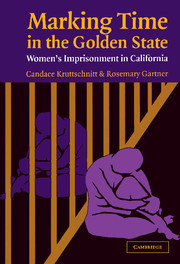Book contents
- Frontmatter
- Contents
- List of Figures and Tables
- Acknowledgments
- Marking Time in the Golden State
- 1 Introduction
- 2 Women, Crime, and Punishment in California
- 3 Entering the Prisons: Methods
- 4 Women's Experiences of Imprisonment at the California Institution for Women in the 1960s and the 1990s
- 5 Variations across Time and Place in Women's Prison Experiences
- 6 Negotiating Prison Life: How Women “Did Time” in the Punitive Era of the 1990s
- 7 Conclusion: The Spectrum of Women Prisoners' Experiences
- Appendix: Characteristics of Interviewees
- References
- Author Index
- Subject Index
3 - Entering the Prisons: Methods
Published online by Cambridge University Press: 15 December 2009
- Frontmatter
- Contents
- List of Figures and Tables
- Acknowledgments
- Marking Time in the Golden State
- 1 Introduction
- 2 Women, Crime, and Punishment in California
- 3 Entering the Prisons: Methods
- 4 Women's Experiences of Imprisonment at the California Institution for Women in the 1960s and the 1990s
- 5 Variations across Time and Place in Women's Prison Experiences
- 6 Negotiating Prison Life: How Women “Did Time” in the Punitive Era of the 1990s
- 7 Conclusion: The Spectrum of Women Prisoners' Experiences
- Appendix: Characteristics of Interviewees
- References
- Author Index
- Subject Index
Summary
Three
our description of the political, demographic, and crime trends in California from the early 1960s to the late 1990s provides a framework not only for understanding how the experience of imprisonment may have changed over time but also for understanding how, and under what conditions, prison research occurs today. While the expansion of the crime control industry spawned a new generation of prisons and enough offenders to exceed their capacity, populist crime policies left criminologists and other social policy experts largely on the sidelines (Zimring et al. 2001; Simon and Feeley 2003). Simon (2000: 285) provides a particularly lucid discussion of how “the pathways of knowledge that made the experience of incarceration” visible during the 1950s and 1960s – what, as we have noted, he refers to as the golden age of U.S. prison sociology – have largely disappeared. As a result, researchers are now notably absent from penal institutions in the United States perhaps because, as some have argued, their expertise is seen as less relevant and their work “is virtually all political risk for prison administrators” (Simon 2000: 303). With this in mind, this chapter describes the explicit and implicit connections between Ward and Kassebaum's study of the California Institution for Women (CIW) in the early 1960s and our work there, and at Valley State Prison for Women (VSPW), over thirty years later.
When we embarked on this study, we thought our methodology was relatively well laid out.
- Type
- Chapter
- Information
- Marking Time in the Golden StateWomen's Imprisonment in California, pp. 39 - 64Publisher: Cambridge University PressPrint publication year: 2004



